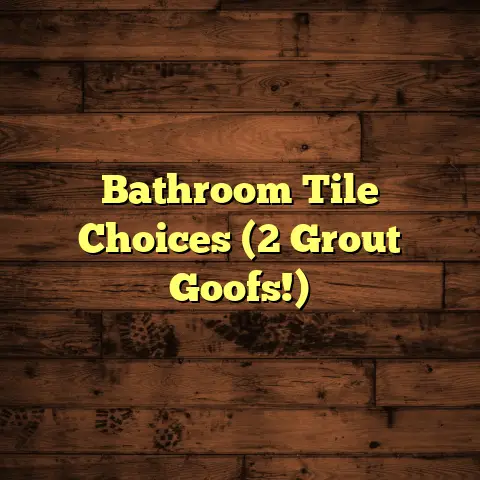Right Grout Color: Tile Designs? (4 Color Traps!)
We’re talking stunning transformations and, well, some not-so-stunning ones.
And you know what’s often the culprit? Grout color. Yep, that seemingly insignificant filler between your gorgeous tiles can make or break your entire design.
It’s more than just a filler. It’s a design element.
I’m going to walk you through what I call the “color traps” – those sneaky pitfalls that can lead to grout color disasters.
Let’s dive in and make sure your next tile project is a showstopper, not a head-scratcher.
Understanding Grout and Its Purpose
So, what exactly is grout?
It’s that paste-like material that fills the spaces between your tiles.
Think of it as the glue that holds your tile masterpiece together, not just physically, but visually too.
Now, there are a few different types, and each has its own strengths:
-
Sanded Grout: This is your workhorse, perfect for most tile installations, especially when you have wider grout lines (1/8 inch or more). The sand adds strength and prevents shrinking.
-
Unsanded Grout: This is your delicate choice for narrow grout lines (less than 1/8 inch), like with glass or polished tiles. The lack of sand prevents scratching.
-
Epoxy Grout: This is your heavy-duty option. It’s stain-resistant, waterproof, and incredibly durable, making it ideal for high-traffic areas or places prone to moisture, like showers and kitchens.
But grout isn’t just about filling gaps. It’s crucial for:
-
Preventing Moisture Penetration: Grout seals those tiny spaces, preventing water from seeping behind the tiles and causing mold, mildew, or structural damage.
-
Allowing for Expansion and Contraction: Tiles expand and contract with temperature changes. Grout provides a flexible buffer, preventing tiles from cracking or popping up.
-
Structural Integrity: Grout helps distribute weight and pressure evenly across the tiled surface, adding to its overall stability.
Think of grout as the unsung hero of your tile installation. It’s not just there to fill space; it’s there to protect, support, and enhance your design.
The Psychology of Color in Design
Okay, let’s get a little philosophical for a moment.
Color isn’t just about what looks pretty. It’s a powerful tool that can evoke emotions, create ambiance, and even influence our behavior.
This is color psychology, and it’s a big deal in design.
Think about it:
- Blue: Often associated with calmness, serenity, and trustworthiness.
- Red: Evokes energy, excitement, and passion.
- Green: Represents nature, growth, and harmony.
- Yellow: Radiates happiness, optimism, and creativity.
But here’s the thing: color perception is subjective.
What looks calming to one person might look boring to another.
Factors like lighting, surrounding colors, and personal preferences all play a role.
And that’s where grout color comes in. It can dramatically alter the perception of your tile patterns and textures.
A light grout can make a dark tile pattern pop, while a dark grout can create a more grounded, cohesive look.
The key is to understand how colors interact and how they affect the overall feel of your space.
It’s not just about picking a color you like; it’s about choosing a color that enhances your design and creates the desired atmosphere.
The Four Color Traps
Alright, buckle up, because we’re about to dive into the heart of the matter: the four color traps that can sabotage your tile dreams.
I’ve seen these mistakes happen time and time again, and I’m here to help you avoid them.
Color Trap 1: Contrast vs. Cohesion
This is a big one. Do you want your grout to stand out or blend in?
A contrasting grout color will highlight the individual tiles, emphasizing the pattern and design.
Think white grout with dark subway tiles – classic, right?
It makes each tile pop and adds a graphic element to the space.
On the other hand, a cohesive grout color, one that closely matches the tile, creates a more seamless, uniform look.
This is great for creating a sense of spaciousness or for letting the texture of the tile take center stage.
Example:
I once worked on a bathroom remodel where the client chose beautiful, textured ceramic tiles in a soft, earthy tone.
They initially wanted a contrasting dark brown grout to define each tile.
But after showing them how a grout color that closely matched the tile would create a more spa-like, serene atmosphere, they changed their minds.
The result was stunning – a seamless, calming space that felt much larger than it actually was.
Ask yourself:
- What do you want to emphasize – the pattern or the overall texture?
- Do you want a bold, graphic look or a more subtle, cohesive feel?
- What is the size of the tile? Smaller tiles tend to look busier with contrasting grout.
Color Trap 2: Light vs. Dark
Light and dark grout colors can have a profound impact on the visual weight of your tile design.
Light grout tends to open up a space, making it feel brighter and airier.
It reflects light and can make smaller rooms feel larger.
It’s a great choice for bathrooms, kitchens, or any space where you want to create a sense of openness.
Dark grout, on the other hand, can ground a space, creating a sense of warmth and intimacy.
It can also hide dirt and stains more effectively than light grout.
It’s a good option for high-traffic areas or spaces where you want a more dramatic, cozy feel.
Case Study:
I remember working on a kitchen renovation where the client chose a beautiful, patterned backsplash tile with a mix of light and dark colors.
They were initially leaning towards a light gray grout to match the lighter tones in the tile.
But I suggested a darker charcoal grout to bring out the darker accents and add depth to the design.
The result was amazing – the darker grout created a dramatic contrast that made the backsplash the focal point of the entire kitchen.
Think about:
- The size of the room.
- The amount of natural light.
- The overall mood you want to create.
Color Trap 3: Warm vs. Cool Tones
Warm and cool grout colors can dramatically influence the overall temperature of a space.
Warm grout colors (think beige, brown, terracotta) can create a cozy, inviting atmosphere.
They tend to work well with natural materials like wood and stone.
Cool grout colors (think gray, blue, green) can create a more modern, refreshing feel.
They pair well with sleek, contemporary designs.
Personal Experience:
I once helped a client choose grout for a bathroom with blue tiles.
They were considering a warm beige grout, thinking it would add warmth to the space.
But I explained that the beige grout would clash with the cool blue tones of the tile, creating a jarring effect.
Instead, we opted for a cool gray grout that complemented the blue tiles perfectly, creating a serene, harmonious space.
Consider:
- The existing color palette of the room.
- The undertones of your tiles.
- The desired temperature of the space.
Color Trap 4: Trend vs. Timeless
This is where things can get tricky.
Design trends come and go, and what’s popular today might look dated tomorrow.
Choosing a grout color based solely on current trends can be a recipe for disaster.
Remember the avocado green and harvest gold of the 70s?
While it might have been all the rage back then, it’s definitely not a timeless look.
Instead of chasing trends, focus on choosing grout colors that align with your personal style and that will stand the test of time.
Guidance:
- Stick to neutrals: White, gray, beige, and brown are always safe bets.
- Consider the style of your home: A classic, traditional home might call for a more traditional grout color, while a modern home might benefit from a bolder choice.
- Don’t be afraid to experiment, but do your research: Look at examples of tile installations that you love and see what grout colors they used.
Remember:
Your tile installation is an investment, so choose a grout color that you’ll love for years to come.
Practical Tips for Choosing the Right Grout Color
Okay, you’ve learned about the color traps. Now, let’s get practical.
Here’s a step-by-step guide to choosing the right grout color for your tile project:
-
Consider Your Tile: What color, pattern, and texture are you working with? This is the foundation of your decision.
-
Define Your Style: Are you going for a modern, traditional, rustic, or eclectic look? Your grout color should complement your overall style.
-
Think About the Space: Is it a small bathroom, a large kitchen, or a hallway? The size and lighting of the space will influence your grout color choice.
-
Grab Samples: This is crucial. Don’t rely on online images or tiny color swatches. Get actual grout samples and place them next to your tiles in the intended environment.
-
Observe in Different Lighting: Look at the samples in natural light, artificial light, and at different times of day. This will give you a true sense of how the grout color will look in your space.
-
Consider Coordinating: Think about the other elements in the room, such as wall paint, fixtures, and cabinetry. Your grout color should complement these elements, not clash with them.
-
Don’t Be Afraid to Ask for Help: Consult with a flooring contractor or interior designer. They can offer valuable insights and help you avoid costly mistakes.
Maintaining Grout Color:
Once you’ve chosen the perfect grout color, it’s important to maintain it over time.
Here are a few tips:
- Seal Your Grout: This will protect it from stains and discoloration.
- Clean Regularly: Use a mild detergent and a soft brush to clean your grout regularly.
- Avoid Harsh Chemicals: Harsh chemicals can damage your grout and cause it to fade.
- Consider Grout Colorant: If your grout becomes stained or discolored, you can use a grout colorant to restore its original color.
Real Talk:
I’ve had clients who skipped the sampling step and regretted it big time.
They ended up with grout colors that clashed with their tiles or that looked completely different in their space than they had imagined.
Trust me, the extra effort of getting samples is well worth it.
Conclusion
Choosing the right grout color is more than just a minor detail; it’s a critical decision that can significantly impact the overall aesthetic of your tile design.
By understanding the purpose of grout, the psychology of color, and the four color traps, you can make informed choices that will enhance your space and create a harmonious, visually appealing result.
Remember, grout isn’t just a filler; it’s a design element that can transform your tile installation from ordinary to extraordinary.
So, take your time, do your research, and don’t be afraid to experiment.
With a little planning and attention to detail, you can create a tile masterpiece that you’ll love for years to come.
Now, go forth and conquer those grout lines! You’ve got this!





